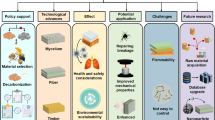Summary
The removal of asbestos-containing building materials requires the use of dust-repelling protective clothing and a respirator. The present study was aimed at measuring physiological responses to asbestos removal in actual work situations. The subjects were eight asbestos workers. During the work, the men wore permeable or impermeable clothing along with a powered or non-powered filtering device including a full-face or half-face mask. Environmental parameters, work postures, heart rate (HR), the skin temperature at two sites and the rectal temperature were recorded every minute during work. Perceived exertion, thermal sensation, thermal comfort, and skin wetness were rated by the subjects. The ambient temperature at work sites ranged from 19° to 37.5°C and relative humidity, from 21% to 50%. The mean HR ranged from 101 to 141 beats min−1. The calculated (from HR measurements) average oxygen consumption (VO2) varied from 0.9 to 1.9 1 min−1 , which corresponded to 27%–60% of the maximal value. The peak rectal temperature and the highest mean of two measurements of skin temperature were 37.7° ± 0.3° C and 34.4° ± 0.9°C, respectively. The sweat rate varied from 162 to 583 g h−1. Poor work posture was common during asbestos removal. The arms were elevated over shoulder level for 35% of the work time. During the work the mean physiological strain was considered to be moderate, with some heavy peak loads being registered. The increases in HR and the thermal responses seemed to be due primarily to the use of simple, nonpowered hand tools, which often required the performance of heavy manual work with the arms held above shoulder level, and less to the protective clothing used. The heat strain during asbestos removal was not excessive because most of the work was done under thermoneutral conditions, and a rest pause of 10–15 min every hour also decreased the thermal strain during work. Improvements in work methods and tools are needed to reduce the peak loads and postural strain experienced during asbestos removal.
Similar content being viewed by others
References
Åstrand P-O, Rodahl K (1977) Textbook of work physiology. McGraw-Hill, New York
Beckett WS, Davis JE, Vroman N, Nadig R, Fortney S (1986) Heat stress associated with the use of vapor-barrier garments. J Occup Med 28:411–414
Borg G (1970) Perceived exertion as an indicator of somatic stress. Scand J Rehabil Med 2:92–98
Brown JR (1965) Impermeable clothing and heat stress. Med Serv J Can 21:518–532
Clay E, Ewing W, Domianek M, Spain W (1986) Protective clothing: a worthwile precaution for asbestos workers. Occup Health Safety 55:27–29
Fanger PO (1970) Thermal comfort. Danish Technical Press, Copenhagen
Ilmarinen R (1989) Effect of work clothing on sweat rate. In: Mital A (ed) Advances in industrial ergonomics and safety, vol 1. Taylor & Francis, London, pp 225–232
Lange Andersen K, Rutenfranz J, Seliger V (1978) Habitual physical activity and health. World Health Organization, Copenhagen
Louhevaara V, Tuomi T, Smolander J, Korhonen O, Tossavainen A, Jaakkola J (1985) Cardiorespiratory strain in jobs that require respiratory protection. Int Arch Occup Environ Health 55:195–206
Louhevaara V, Hakola T, Ollila H (1990a) Physical work and strain involved in manual sorting of postal parcels. Ergonomics (in press)
Louhevaara V, Sovijärvi A, Ilmarinen J, Teräslinna P (1990b) Differences in cardiorespiratory responses during and after arm crank and cycle exercise. Acta Physiol Scand 138:133–143
Mazurkiewicz MG, Wage] LA (1988) Heat stress in asbestos abatement. Proceedings of the AIH Conference 1988, San Francisco
Nunneley S (1989) Heat stress in protective clothing: interactions among physical and physiological factors. Scand J Work Environ Health 15 [Suppl 1]:52–57
Rohmert W, Landau K (1983) A new technique for job analysis. Taylor & Francis, London
Saltin B, Hermansen L (1966) Esophageal, rectal and muscle temperature during exercise. J Appl Physiol 25:679–688
Shvartz E, Benor D (1972) Heat strain in hot and humid environments. Aerospace Med 43:852–855
Smolander J, Louhevaara V, Tuomi T, Korhonen O, Jaakkola J (1984) Cardiorespiratory and thermal effects of wearing gas protective clothing. Int Arch Occup Environ Health 54:261–270
Smolander J, Ilmarinen R, Korhonen O, Pyykkö I (1987) Circulatory and thermal responses of men with different training status to prolonged physical work in dry and humid heat. Scand J Work Environ Health 13:37–46
Tanaka M, Brisson GR, Volle MA (1978) Body temperatures in relation to heart rate for workers wearing impermeable clothing in a hot environment. Am Ind Hyg Assoc J 39:85–89
White MK, Hodous TIC (1987) Reduced work tolerance associated with wearing protective clothing and respirators. Am Ind Hyg Assoc J 48:304–310
White MK, Hodous TK, Hudnall JB (1989a) Physiological and subjective responses to working in disposable protective coveralls and respirators commonly used by the asbestos abatement industry. Am Ind Hyg Assoc J 50:313–319
White MK, Vercruyssen M, Hodous TK (1989b) Work tolerance and subjective responses to wearing protective clothing and respirators during physical work. Ergonomics 32:1111–1123
Author information
Authors and Affiliations
Additional information
This study was financially supported by the Finnish Work Environmental Fund
Rights and permissions
About this article
Cite this article
Rissanen, S., Smolander, J. & Louhevaara, V. Work load and physiological responses during asbestos removal with protective clothing. Int. Arch Occup Environ Heath 63, 241–246 (1991). https://doi.org/10.1007/BF00386372
Received:
Accepted:
Issue Date:
DOI: https://doi.org/10.1007/BF00386372




